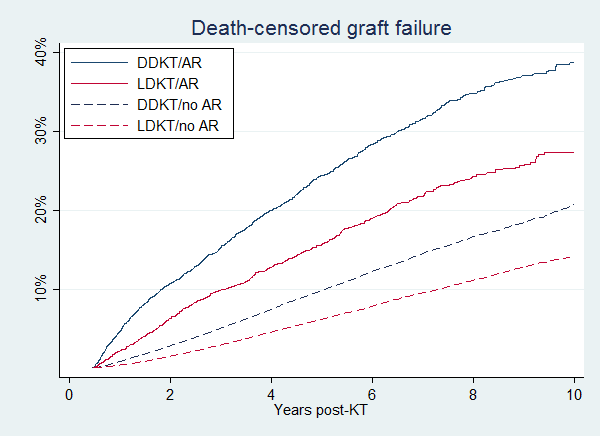Acute Cellular Rejection Is Associated with Increased Risk of Early and Late Graft Failure.
JHU, Baltimore
Meeting: 2017 American Transplant Congress
Abstract number: 530
Keywords: Graft failure
Session Information
Session Name: Concurrent Session: Long Term Kidney Graft Survival II
Session Type: Concurrent Session
Date: Tuesday, May 2, 2017
Session Time: 4:30pm-6:00pm
 Presentation Time: 4:30pm-4:42pm
Presentation Time: 4:30pm-4:42pm
Location: E450a
The association between acute cellular rejection and subsequent early and late graft loss has not been well-quantified.
METHODS: Using SRTR data and Cox regression, we studied the association between acute rejection in the first six months (AR6) and death-censored graft failure (DCGF) among 83,008 deceased donor kidney transplant (DDKT) recipients 2005-2015 with ≥6m graft survival, adjusting for recipient characteristics and KDPI; and among 48,399 living donor kidney transplant (LDKT) recipients, adjusting for recipient characteristics and living donor KDPI.
RESULTS: Cumulative incidence of DCGF at 10y post-KT was higher for recipients with AR6 among both DDKT recipients (38.8% vs 20.7%) and LDKT recipients (27.3% vs 14.4%) (Figure). Among DDKT recipients, AR6 was associated with 4-fold higher risk of DCGF in the first year post-KT (aHR=4.1 4.9 5.6, p<0.001); this association attenuated over time, but remained statistically significant >5 years post-KT (aHR=1.3 1.5 1.8, p<0.001) (Table). Similarly, among LDKT recipients, AR6 was associated with 4-fold higher risk of DCGF in the first year post-KT (aHR=3.4 4.6 6.3, p<0.001); this association also attenuated over time, but remained statistically significant >5 years post-KT (aHR=1.3 1.6 1.9, p<0.001).
CONCLUSIONS: Acute rejection in the first six months is associated with substantially increased risk of early and late graft loss, with continued risk even beyond 5 years, both in deceased and live donor transplants. This persistent late risk of graft loss is consistent with mechanistic theories that acute cellular rejection primes the immune system for later development of de novo DSA and subsequent injury to the allograft.
| DDKT | LDKT | |
| 0.5-1y post-KT | 4.2 4.9 5.6 | 3.4 4.6 6.3 |
| 1-3y post-KT | 2.1 2.3 2.6 | 2.3 2.7 3.1 |
| 3-5y post-KT | 1.6 1.8 2.0 | 1.3 1.6 1.9 |
| >5y post-KT | 1.3 1.5 1.8 | 1.3 1.6 1.9 |
CITATION INFORMATION: Massie A, Garonzik-Wang J, Segev D. Acute Cellular Rejection Is Associated with Increased Risk of Early and Late Graft Failure. Am J Transplant. 2017;17 (suppl 3).
To cite this abstract in AMA style:
Massie A, Garonzik-Wang J, Segev D. Acute Cellular Rejection Is Associated with Increased Risk of Early and Late Graft Failure. [abstract]. Am J Transplant. 2017; 17 (suppl 3). https://atcmeetingabstracts.com/abstract/acute-cellular-rejection-is-associated-with-increased-risk-of-early-and-late-graft-failure/. Accessed January 6, 2026.« Back to 2017 American Transplant Congress

